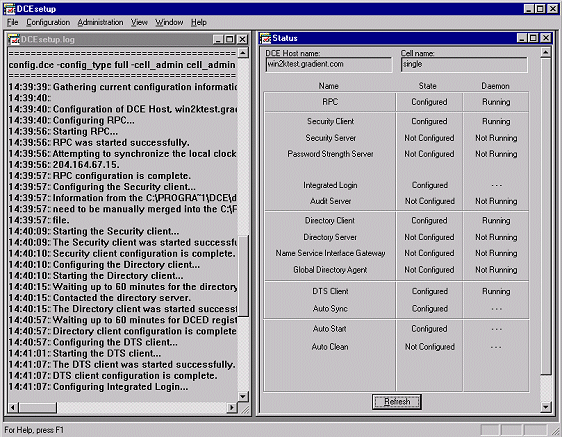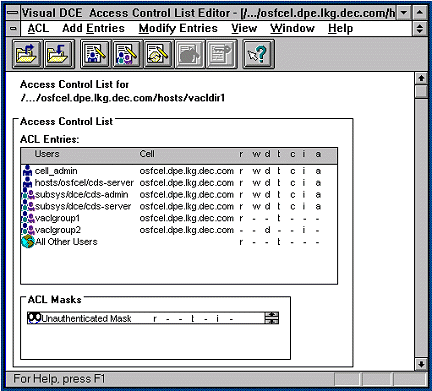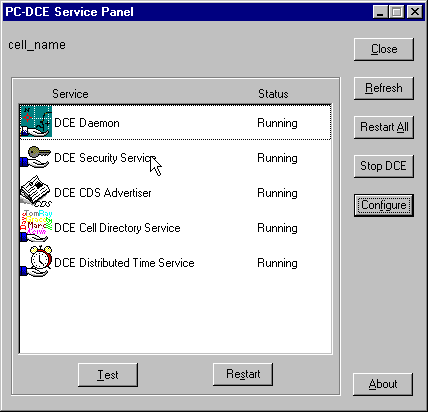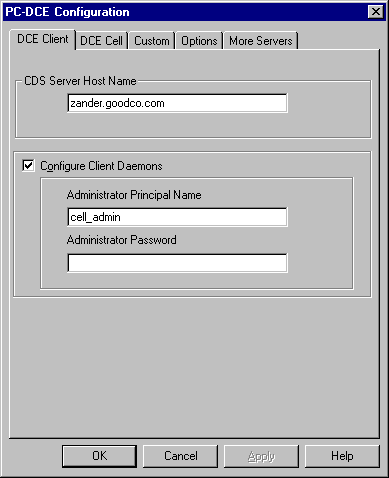
[Previous] [Next] [Contents] [Index]
This chapter contains the following sections:
1.2 How PC-DCE Implements DCE Under Windows
1.3 Special Features
1.4 PC-DCE Kit Components
1.1 OSF DCE Overview
By distributed computing we mean computing that involves the cooperation of two or more machines communicating over a network. The machines participating in the system can range from personal computers to supercomputers; the network can connect machines in one building or on different continents.
1.2 How PC-DCE Implements DCE Under Windows
This section discusses how PC-DCE implements specific aspects of OSF DCE in a Windows environment.
1.2.1 Client/Server Architecture
A PC-DCE cell includes client systems and at least one system installed with server components. Each cell member running Windows must have the PC-DCE Client Runtime installed. The runtime component is included in both the Server kit and the Client Runtime kit.
1.2.1.1 Server
NOTE:
The nsid can also function as a client.
The implementation of the client components under Windows is treated in detail in Chapter 2.
The dce_service process also performs the following housekeeping functions:
On all supported Windows operating systems except Windows 98, PC-DCE uses the Microsoft endpoint mapper service, rpcss.exe, to provide socket lookup services for applications. Enable Endpoint Service Only on the Options tab of the PC-DCE Configuration Panel to start the DCE endpoint primer, which determines if rpcss.exe is running, and starts it if it is not. See Section 1.2.3 on page 10.
On Windows 98, dced.exe provides endpoint mapping services.
1.2.4 Error Message Handling
On Windows 98, DCE errors are logged to the install_directory\dce32.log file.
1.2.5 Environment
DCE environment information (environment variables, path information, login credentials, and so on.) is incorporated into the Windows Registry and system environment variables. You can modify registry keys and environment variables to fine-tune PC-DCE behavior.
1.2.6 Integrated Login
The integrated login feature also detects when the user changes his Windows password and automatically updates the DCE password.
1.2.7 Pthreads
PC-DCE offers the common DCE pthread API, but uses the available Windows kernel threads under that interface. This integration lets developers monitor pthreads using native Windows tools such as the Performance Monitor and the Process Viewer provided with the Win32® Software Developer's Kit and Resource Kit.
1.2.8 PC-DCE Tools
You can manage PC-DCE using a variety of graphical and command-line tools.
1.2.8.1 DCEsetup
DCEsetup, shown in Figure 1-1, is a tool that provides an easy-to-use graphical interface for configuring DCE services on your Windows system. With DCEsetup, you can configure the following DCE components:

![]()
For more information on using DCEsetup, refer to the DCEsetup online help system.
1.2.8.2 DCE Director
The DCE Director is a graphical tool for managing DCE cells. The DCE Director (Figure 1-2) makes it easy to perform management tasks, such as creating, deleting, and modifying user accounts, security groups, and CDS directories. In addition, the DCE Director allows you to access the standard DCE control programs (rgy_edit, cdscp, acl_edit, and dtscp), while providing new functions, such as allowing authorized users to preconfigure host machines in a cell and manage user accounts.
The DCE Director includes an enhanced ACL editor, the Visual DCE ACL Editor (see Section 1.2.8.3 on page 14), which allows you to graphically manage ACLs. You can invoke the Visual ACL Editor directly from the DCE Director or you can use it as a stand-alone tool by clicking its icon in the DCE program group.
If you are not using DCE Director, you can use the DCE command line tools as described in PC-DCE Administrator's Guide to perform the same functions.
1.2.8.3 Visual DCE ACL Editor
The Visual DCE ACL Editor (Figure 1-3) makes it easy for you to set the permissions for all security-relevant objects within DCE, including Registry objects and CDS objects. It allows you to display, add, modify, copy, and remove ACL entries for a specific object in a cell's namespace. You can also go past junctions to application-specific namespaces and set permissions on the ACLs of application-specific objects.
Figure 1-3: Visual DCE ACL Editor

![]()
Among the tasks you can perform using the ACL Editor are the following:
For more information on the Visual DCE ACL Editor, refer to the Visual DCE ACL Editor online help system.
1.2.8.4 PC-DCE Service Panel
On all Windows platforms supported, you can use the graphical PC-DCE Service Panel (Figure 1-4) to start, stop, test and review the operational status of individual DCE components.
Figure 1-4: PC-DCE Service Panel

![]()
NOTE:
On all supported Windows operating systems except Windows 98, you
can also use the Windows Services control panel to stop and restart PC-DCE.
1.2.8.5 PC-DCE Configuration Panel
The PC-DCE Configuration panel (Figure 1-5) provides an additional tool for configuring DCE cells, servers, and clients.
Figure 1-5: PC-DCE Configuration Panel

![]()
1.2.8.6 DCE Command Line Tools
PC-DCE fully implements dcecp (Distributed Computing Environment Control Program), the primary command-line management interface for managing DCE. dcecp allows you to manage core DCE administrative functions and administer DCE components remotely.
1.3 Special Features
In addition to the standard DCE functionality in The Open Group's DCE, PC-DCE provides some added features.
1.3.1 Lightweight Client
You can choose to configure a lightweight DCE client, which does not configure the dced, dtsd or cdsadv client daemons. This lightweight configuration reduces computing overhead on the client system and eliminates the need for you to specify the cell administrator principal and password during the configuration process. The lightweight client is discussed in detail in Chapter 2.
1.3.2 Per-Thread Login Contexts
PC-DCE enhances standard DCE to allow default login contexts on a per-thread basis. Your application calls sec_login_set_thread_context() to set up the thread-specific context. Then, calling sec_login_get_current_context() from that thread returns the per-thread context rather than the process-wide context.
1.3.3 CDS Preferencing
CDS preferencing lets you assign ranks to clearinghouses in a preference file, which PC-DCE reads at startup. In this way, you control a client's preference for CDS clearinghouses. CDS preferencing is useful in situations where multiple clearinghouses exist; if some of the clearinghouses are connected to the client's LAN by a low-performance WAN link, you can assign preference to a local clearinghouse.
1.3.4 Co-Authentication Service
The PC-DCE Co-Authentication Service (CAS) provides developers with the ability to plug alternative authentication methods into PC-DCE. A user logging in through CAS uses an alternative authentication method, for example a biometric device such as a fingerprint scanner, to obtain DCE login credentials.
1.3.5 C++ Support
PC-DCE includes an enhanced IDL compiler that supports C++ based application development. Developers can write client and server programs that access C++ objects transparently, independent of their location. C++ features such as inheritance and object references are supported.
1.3.6 Microsoft Terminal Server
PC-DCE v4.1 provides support for systems running Windows NT Terminal Server and Windows 2000 Terminal Server. This support is only available when you purchase PC-DCE specificlly to run in a Terminal Server Environment. The licence and cofiguration need to account for multiple clients configured with the Terminal Server. Special requirements at installation are explaind in the PC-DCE Installation and Release Notes.
1.3.7 Designating a Local Configuration Administrator
The preconfig.tcl script has been updated to include NetCrusader/Web support.
NOTE:
Other Entegrity products, DCE for Linux and DCE for Tru64 UNIX use
a similar term for something different. There, split server configuration is
where the CDS and Security master servers are on different hosts in a cell.
Information You Need to Run preconfig.tcl
The preconfig.tcl script asks for the following information:
The entity (single or group) name must have a valid login in the cell to which the client machine will belong.
What the Script Does
Installation steps are in the PC-DCE Administrator's Guide section 2.3.1. See the PC-DCE Configuration Panel help file for information about configuring clients.
1.4 PC-DCE Kit Components
PC-DCE kits are available in domestic and export versions. Due to U.S. federal trade restrictions, encrypted RPC (packet privacy) and encryption via the GSSAPI are disabled in the export kit.
1.4.1 Client Runtime Kit
The Client Runtime Kit includes the PC-DCE runtime software, the message catalogs, sample client/server programs, and basic administration utilities.
1.4.2 Server Kit
PC-DCE Server Kit includes the client runtime, CDS server, and standard security server.
1.4.3 Application Developer's Kit
[Previous] [Next] [Contents] [Index]
To make comments or ask for help, contact support@entegrity.com.
Portions of this document were derived from materials provided by Compaq Computer Corporation. Copyright © 1998-2003 Compaq Computer Corporation.